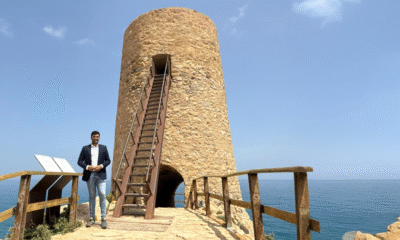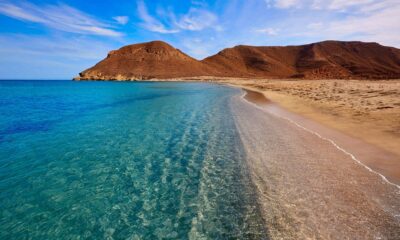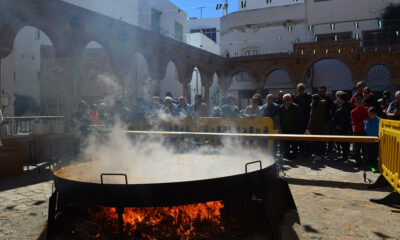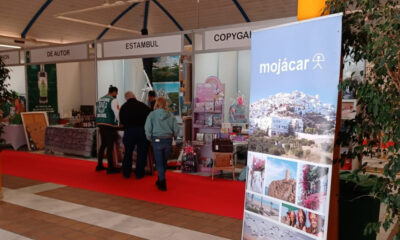In Almería
Take a Peek Inside Pulpí’s Giant Geode
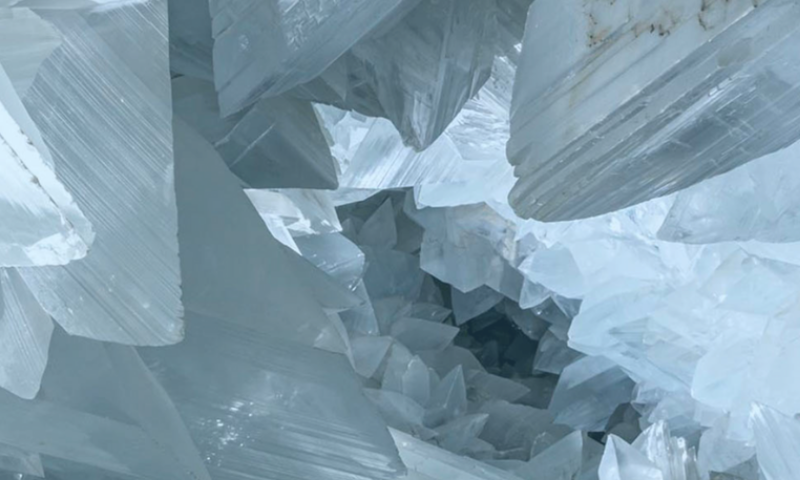
Location of La Geoda de Pulpí
Address: Poligono S-AG2A, 33, 04640 Pulpí, Almería
In december 1999, members from Madrid’s Mineralogist Group discovered Pulpí’s Geode in Mina Rica, a colossal mineral geode measuring 8 metres length times 2 metres height fully covered in huge gypsum crystals. It’s upholstered with gypsum crystals, some of them measuring 2 metres long. Its transparency and spotlessness make it a wonder of nature. Given its dimensions as well its crytals size, transparency and perfection, this is a unique phenomenon worldwide (Calaforra & García-Guinea, 2000).
The origin of this outlandish geode can be explained in two stages: the gap formation and the subsequent mineral deposit on the inside. The gap was produced by dolomite karstifications that make up the Sierra del Aguilón, accompanied hidro-termal volcanic shots. The mineral deposit could follow a mixed model (Karstic and hidro-termal).
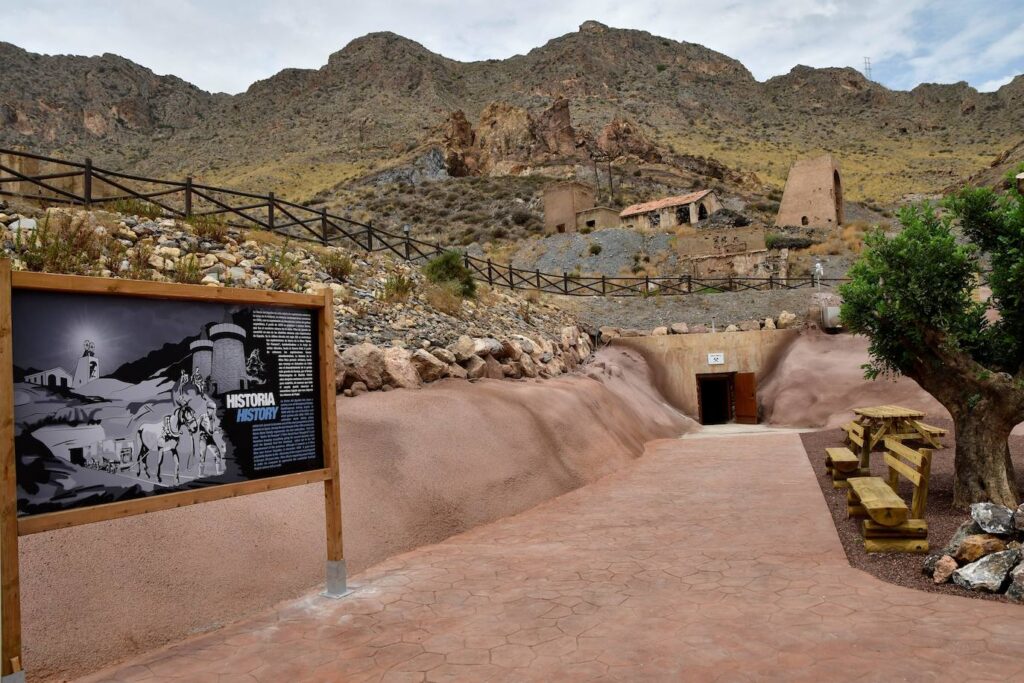
Geologists describe a geode as a spherical or egg-shaped rock with a sparkly hidden treasure inside: a hollow cavity lined with crystal formations. They’re not particularly rare; geodes are found all over the world, especially in deserts. The kind of crystals they contain depends on factors like location, temperature and the type of rock the geode is formed from.
They can be as small as a centimetre or so long. What makes the Pulpí geode so special is its spectacular size. At approximately eight metres long, two metres wide and two metres high, and covered with translucent gypsum crystals up to nearly two metres in length it is widely regarded as the world’s largest accessible geode.
Members of the Madrid Mineralogist Group discovered the geode in 1999 during an expedition to the abandoned Mina Rica mine in Pulpí’s Aguilón mountains. Some 60 metres down they spotted gypsum crystals on the wall of a hole. Intrigued, they made the hole big enough to get through and found they were looking at an incredible geological phenomenon.
The geode was formed in two phases. First, there was the formation of the hole due to the karstification of the rocks which make up the Sierra del Aguilón, then the mineral deposits which became the crystals. The crystals are 165,000 years old. See it for yourself if you’re interested in learning about a key chapter of Costa de Almería history or looking for something different to do, the 90-minute guided tour of the Mina Rica and the chance to see the giant geode for yourself are definitely worth it.
Specialised guides take visitors through the main galleries and spectacular chambers created by miners to exploit the mineral riches inside the mountain. They talk about the mine geology, show you traces of unusual minerals and explain how different types of ore – lead, iron and silver – were extracted and transported to the coast from the mid-19th century until the mine closed in the 1960s. A lot of thought has gone into giving visitors an insight into what life down in the mine was like. You see details like tools the miners used, what they wore and how they ate and drank during their long hours toiling under the earth.
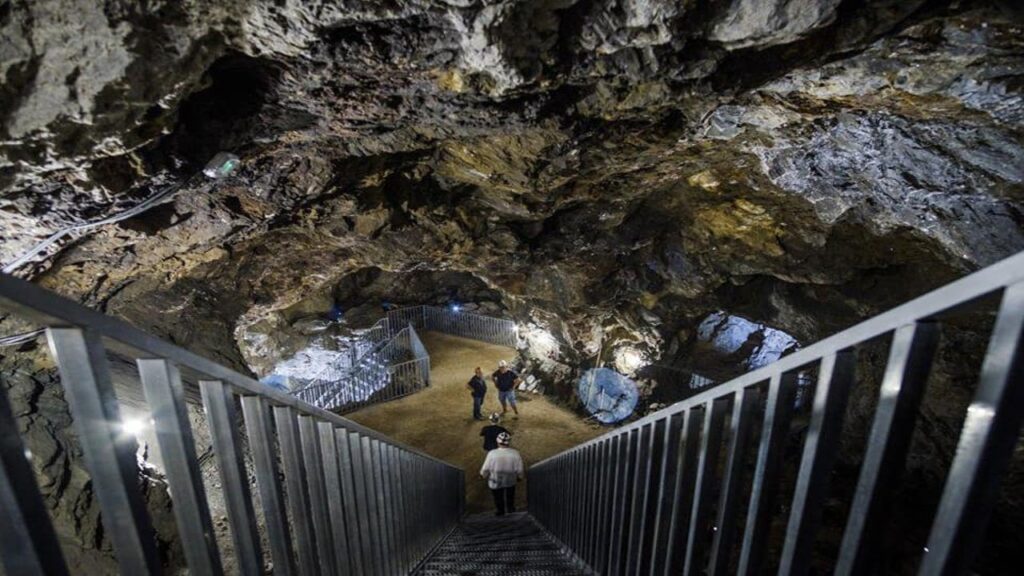
The guides know their stuff and are happy to answer questions. The tour highlight comes at the end when you get to look inside the jewel in the mine’s crown: the huge geode. It’s located between the third and fourth levels, and to reach it you walk down a 15-metre spiral staircase or go down in a lift. You can’t go inside the geode because the crystals are easily damaged, but take your turn to stick your upper body through the aperture and marvel at this amazing creation of Mother Nature.
Visits must be booked in advance, which you can do easily by going to the official Pulpí geode website. The ticket includes entry to the castle in San Juan de los Terreros, where you can experience a virtual tour of Mina Rica and the geode. You’re advised to get to Mina Rica 30 minutes before your visit begins to give you time to pick up the sticker which identifies you as booked on a tour.
If you have time to spare you can take in the views of the surrounding area or check out the gift shop. Items for sale include minerals extracted from Mina Rica, jewellery and various gifts. Proceeds go towards preserving the mine and the geode and the costs of keeping it open to the public. Tours are in groups of up to 12 and are in Spanish, but it’s possible to book group visits of up to 15 with an English-speaking guide. Alternatively, there are audio guides in English, French, German and Flemish available at the information office.
There’s a fair bit of walking and going up and down steps between the different levels of the mine; 80 in fact without including the staircase to the geode. You should wear comfortable clothes and appropriate footwear. If you have certain medical conditions or mobility issues you should check whether they prevent from you being allowed to do the tour. Earlier this year the Junta de Andalucía awarded Mina Rica and the geode “Natural Monument” status in recognition of their environmental and geological value and uniqueness and to guarantee their preservation.
The opportunity to visit them is a privilege and it’s essential to respect the regulations designed to protect them and ensure visitors’ safety. You must wear the helmet given to you at the mine entrance throughout the tour. The same goes for face masks. You’re not allowed to take bags into the mine, touch the minerals, crystals or structures inside or take your own photos. The guides take pics of each person in their group at the main points of interest, including the giant geode, and for just one euro they’ll email you memorable images of yourself in this remarkable underground world.
For more information and to book tickets 950 962 727 informacion@geodapulpi.es http://www.geodapulpi.es
In Almería
Discover Coastal Paradise: Hiking or Biking from Villaricos to Mar de Pulpí
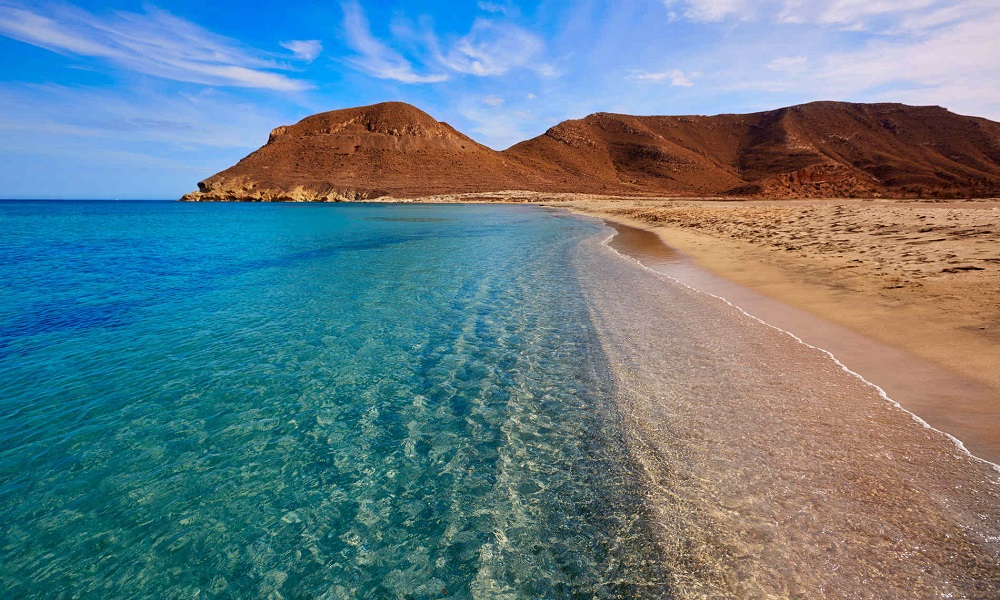
Are you yearning for a dose of sunshine, stunning scenery, and a touch of Andalusian charm? Look no further than the coastal route stretching between the traditional fishing village of Villaricos and the modern coastal development of Mar de Pulpí. This isn’t just a hike or bike ride; it’s an immersive experience into the heart of Almería’s captivating coastline.
A Journey for Every Explorer
Whether you’re a seasoned hiker seeking a new challenge or a leisurely cyclist wanting to soak up the views, this route offers something for everyone. Covering approximately 15-20 kilometers (9-12 miles), the trail winds its way along the Mediterranean, promising unforgettable sights and sounds.
What to Expect Along the Way:
- Villaricos: Where Tradition Meets Tranquility: Begin your adventure in Villaricos, a quintessential Spanish fishing village. Wander along the tranquil beaches, savor the aroma of freshly caught seafood, and immerse yourself in the authentic atmosphere. This is a great place to stock up on supplies before you set off on your adventure!
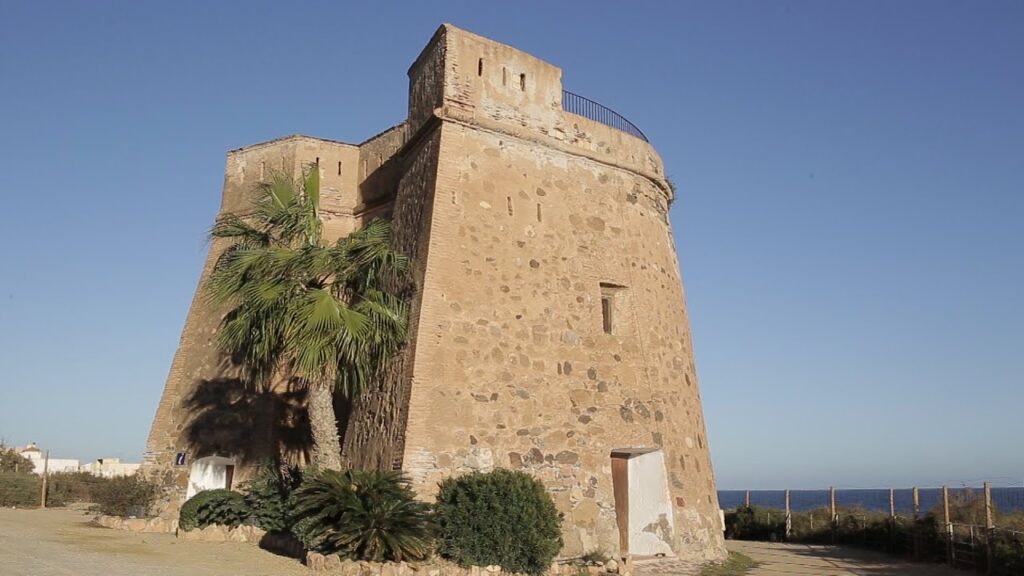
Castillo in Villaricos
- San Juan de los Terreros: History and Heavenly Beaches: Your journey continues to San Juan de los Terreros, a town steeped in history and blessed with stunning beaches. Be sure to visit the Castillo de San Juan de los Terreros.
- Mar de Pulpí: Modern Mediterranean Marvel: Conclude your adventure in Mar de Pulpí, a testament to modern coastal design. Admire the Mediterranean architecture, enjoy the modern amenities, and revel in the culmination of your scenic journey.
Must-See Highlights:
- Hidden Coves and Sparkling Beaches: The coastline is dotted with secluded coves and inviting beaches. Pack your swimsuit and take a refreshing dip in the crystal-clear waters of the Mediterranean!
- Dramatic Cliffs and Azure Vistas: Prepare to be mesmerized by the dramatic cliffs that plunge into the azure sea. The views are simply breathtaking, offering perfect photo opportunities.
- Castillo de San Juan de los Terreros: Ascend to the historic castle of San Juan de los Terreros and be rewarded with panoramic views of the coastline. Imagine the history that has unfolded within these ancient walls.
Tips for Your Coastal Adventure:
- Preparation is Key: Pack plenty of water, sunscreen, a hat, and comfortable clothing. Sturdy shoes are a must for hiking.
- Navigate with Confidence: While the route is generally well-marked, a reliable map or GPS device is recommended. Wikiloc is a fantastic resource for detailed routes and user reviews.
- Weather Wise: Check the weather forecast before you set off. The Andalusian sun can be intense, so be prepared for warm conditions.
Don’t Miss Out!
The coastal route from Villaricos to Mar de Pulpí is more than just a hike or bike ride; it’s an opportunity to connect with nature, immerse yourself in Andalusian culture, and create lasting memories. So, pack your bags, grab your camera, and prepare to discover the hidden gems of Almería’s captivating coastline.
Related Articles:
- Sun, Sand, and Seclusion: Discover the Best Beaches in Almería
- Lace Up Your Boots: Discover the Best Hiking Trails in Almería
- Villaricos: A Taste of Authentic Almería on the Coast
Have you experienced this route? Share your experiences and mail us on info@visiting-almeria.com!
In Almería
Villaricos: A Taste of Authentic Almería on the Coast
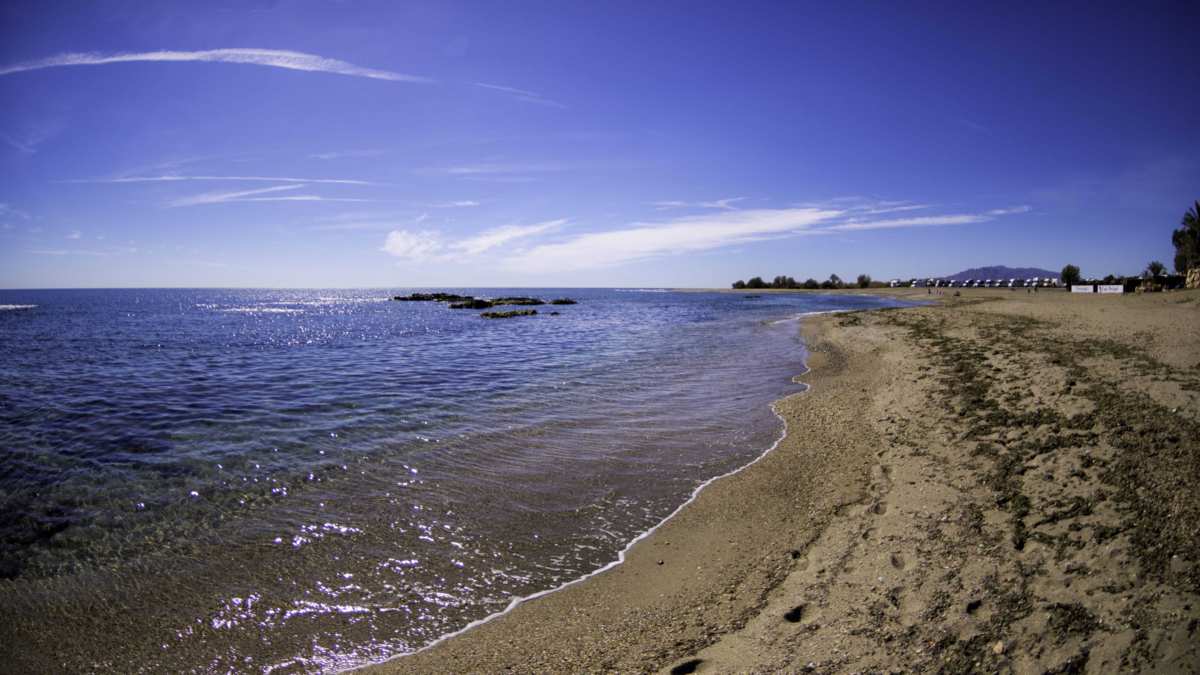
Escape the hustle and bustle of modern life and step back in time in Villaricos, a charming fishing village nestled along the Almería coast. With its tranquil beaches, traditional atmosphere, and captivating history, Villaricos offers a truly authentic glimpse into Andalusian life. If you’re seeking a relaxing getaway where you can soak up the sun, savor fresh seafood, and immerse yourself in local culture, Villaricos is the perfect destination.
[Insert a captivating horizontal image of Villaricos. It could be a scenic shot of the harbor with colorful fishing boats, a view of the village from the coast, or a picture of the beach at sunset.]
More Than Just a Pretty Beach: A Village with History and Heart
Villaricos isn’t just a beautiful coastal village; it’s a place with a rich history and a vibrant community. Wander through its narrow streets, admire the traditional architecture, and feel the warmth of the local people.
Why You’ll Fall in Love with Villaricos:
- Tranquil Beaches: Relax and unwind on Villaricos’ peaceful beaches. The calm waters are perfect for swimming, sunbathing, or simply enjoying the stunning coastal views.
- Authentic Fishing Village Atmosphere: Experience the authentic charm of a traditional fishing village. Watch the fishermen bring in their daily catch, soak up the local atmosphere, and enjoy a slower pace of life.
- Fresh Seafood Delights: Indulge in the freshest seafood at Villaricos’ charming restaurants. From grilled sardines to paella bursting with flavor, you’ll find a culinary delight to satisfy your taste buds.
- El Castillo de Villaricos A historic castle is located in Villaricos, and should be visited to take in the history.

Castillo in Villaricos
- The Sunday Market: Every Sunday Villaricos comes alive with one of the biggest street markets in the area.
- A Gateway to Coastal Adventures: Villaricos is the perfect starting point for exploring the surrounding coastline. Hike or bike along the scenic coastal route to nearby towns like Mar de Pulpí and San Juan de los Terreros.
Things to See and Do in Villaricos:
- Stroll along the harbor: Watch the fishing boats bobbing in the harbor and soak up the atmosphere.
- Relax on the beach: Spend a day sunbathing, swimming, or simply enjoying the stunning coastal views.
- Dine at a local restaurant: Savor the freshest seafood and experience the authentic flavors of Almería.
- Hike or bike along the coastal path: Explore the surrounding coastline and discover hidden coves and beaches.
- Visit the Sunday Market: Enjoy the Villaricos market to get a good deal.
Tips for Planning Your Trip to Villaricos:
- Accommodation: Choose from a range of hotels, apartments, and guesthouses in Villaricos.
- Getting Around: Villaricos is a small village that is easily explored on foot. You can rent a car or bicycle to explore the surrounding area.
- Best Time to Visit: Villaricos is beautiful year-round, but the best time to visit is during the spring or autumn when the weather is mild and the crowds are smaller.
Experience the Magic of Villaricos:
Villaricos is a hidden gem waiting to be discovered. If you’re looking for an authentic and relaxing coastal getaway, be sure to add Villaricos to your Almería itinerary.
Have you visited Villaricos? Share your experiences and mail us on info@visiting-almeria.com!
In Almería
Lace Up Your Boots: Discover the Best Hiking Trails in Almería
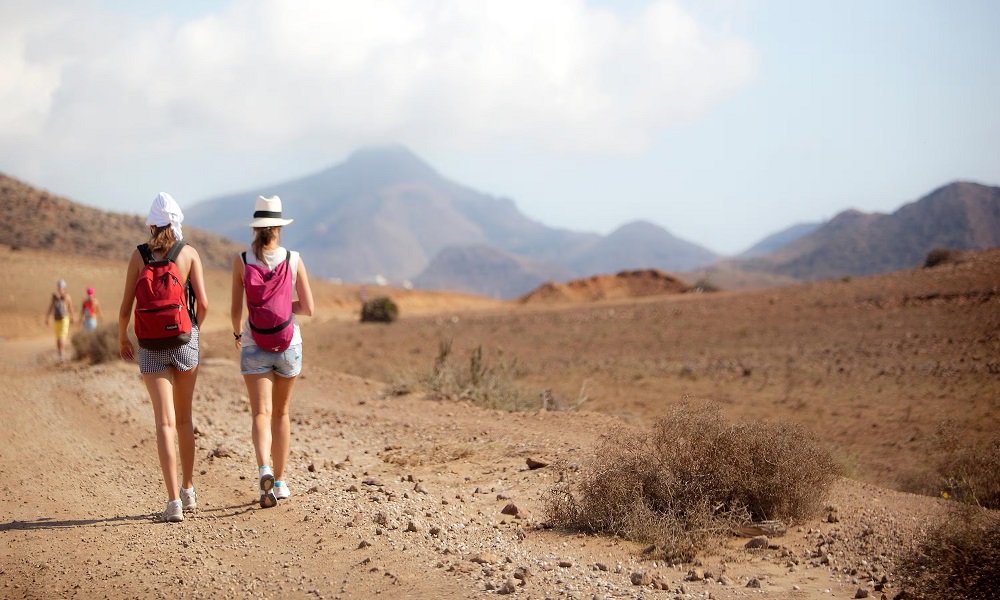
Beyond its stunning coastline and captivating cities, Almería boasts a dramatic interior landscape that is just begging to be explored on foot. From challenging mountain ascents to leisurely coastal walks, Almería offers a diverse range of hiking trails to suit every level of experience. Get ready to lace up your boots, breathe in the fresh air, and discover the hidden beauty of Almería!
Almería’s unique geography creates a hiker’s paradise. Imagine trekking through lunar-like desert landscapes, scaling volcanic peaks with breathtaking views, or following ancient paths through lush valleys. Prepare to be amazed by the raw beauty and unspoiled wilderness of this Spanish province.
Top Hiking Trails to Explore:
- Sendero de los Tres Pueblos (PR-A 360): A Journey Through the Alpujarra Almeriense This scenic route loops through the charming villages of Beires, Almócita and Padules in the Alpujarra Almeriense, offering stunning views of the valleys.
- Natural Park of Cabo de Gata – Barranco Hondo and Mesa Roldán (SL-A 166): Coastal Beauty and Volcanic Views This hike combines coastal beauty with volcanic landscapes, taking you through the Barranco Hondo (Deep Ravine) to the iconic Mesa Roldán, a volcanic plateau with panoramic views of the coastline.
- Natural Park of Cabo de Gata – Castle of San Pedro from Las Negras: This walk takes you from the village of Las Negras along the coast to the ruins of the Castillo de San Pedro.
- Parque Natural de Cabo de Gata – circular to Morrón de los Genoveses from San José: This is a circular hike that goes to a high point known as Morrón de los Genoveses from the town of San José.
- Parque Natural de Cabo de Gata – Loma Pelada trail (SL-A 103): Discovering Hidden Coves and Volcanic Formations This coastal trail winds its way along the cliffs of the Cabo de Gata Natural Park, revealing hidden coves, dramatic volcanic formations, and breathtaking sea views.
Essential Hiking Tips for Almería:
- Plan Your Route: Research your chosen trail and assess its difficulty level. Consider factors like distance, elevation gain, and terrain.
- Check the Weather: Almería’s climate can be unpredictable. Check the weather forecast before you go and be prepared for changing conditions.
- Gear Up: Wear appropriate hiking boots with good ankle support. Pack layers of clothing, a hat, sunscreen, and sunglasses.
- Stay Hydrated: Carry plenty of water, especially during the warmer months. A reusable water bottle is a must.
- Navigation: Bring a map, compass, or GPS device. Familiarize yourself with the trail markings.
- Tell Someone: Let someone know your hiking plans, including your route and expected return time.
Leave No Trace:
Respect the environment and leave no trace behind. Pack out all your trash, stay on marked trails, and avoid disturbing wildlife.
Ready to Hit the Trails?
Almería’s hiking trails offer a unique opportunity to connect with nature, challenge yourself physically, and discover the hidden wonders of this captivating province. So, grab your gear, choose your adventure, and get ready to explore!
What are your favorite hiking trails in Almería? Share your experiences and mail us on info@visiting-almeria.com!
-
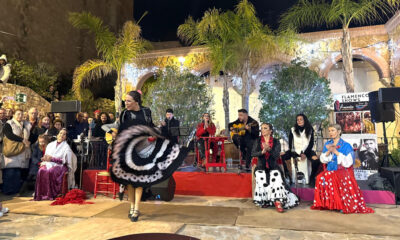
 City News6 months ago
City News6 months agoMojácar Shines as a Model for Christmas Tourism with its Zambomba Flamenca
-
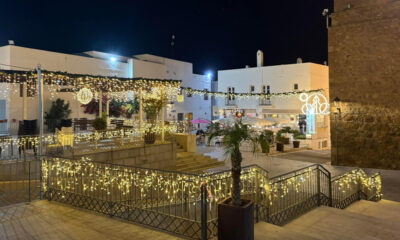
 City News7 months ago
City News7 months agoMojácar Launches its Unique and Innovative Christmas Soundtrack
-
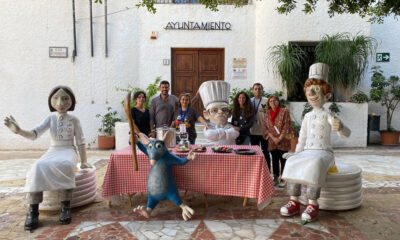
 City News8 months ago
City News8 months agoDisney Magic Takes Over Mojácar: Successful Third Edition of the Family Event
-
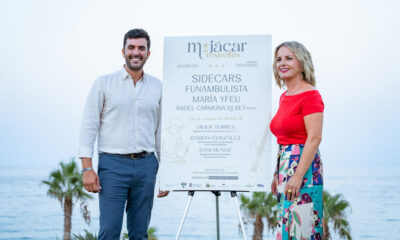
 City News11 months ago
City News11 months agoMojácar “Cinco Estrellas”: A new benchmark in Quality Tourism
-
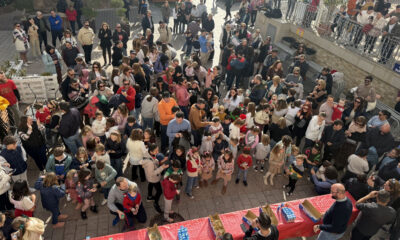
 City News6 months ago
City News6 months agoMojácar Says Goodbye to the Year With the Fifth Edition of its Children´s New Year´s Eve
-
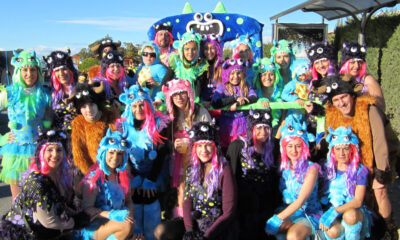
 City News5 months ago
City News5 months agoMojácar Ready to Celebrate Carnival 2025 with a Program Full of Color and Fun
-
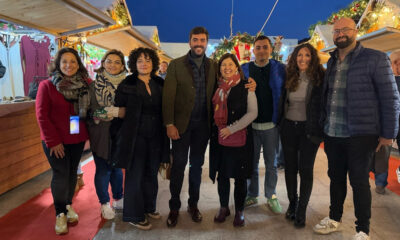
 City News7 months ago
City News7 months agoThe Mojácar Christmas Market Dazzles With its Spectacular Opening
-
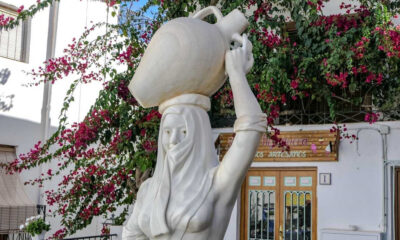
 City News10 months ago
City News10 months agoThe Mojácar Woman Sculpture Turns 35 Coinciding With the Saint Augustine Festivities

